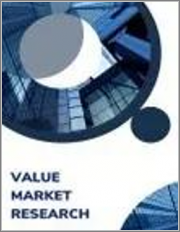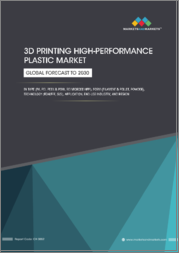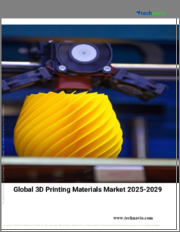
|
시장보고서
상품코드
1332723
세계의 3D 프린팅 세라믹 시장 조사 보고서 : 산업 분석, 규모, 점유율, 성장, 동향 및 예측(2023-2030년)Global 3D Printing Ceramics Market Research Report - Industry Analysis, Size, Share, Growth, Trends and Forecast 2023 to 2030 |
||||||
3D 프린팅 세라믹 시장의 세계 수요는 2023-2030년의 조사 기간 동안 CAGR 27.2%로 성장하여 2022년 4,043만 달러에서 2030년 거의 2억 7,7055만 달러 규모에 도달할 것으로 추정됩니다.
3D 프린팅 세라믹은 세라믹의 적층 가공라고도 불리는데, 3D 프린팅 기술을 이용해 세라믹 물체를 층층이 쌓아 올리는 혁신적인 제조 공정입니다. 세라믹은 우수한 기계적, 열적, 전기적 특성으로 유명한 다양한 유형의 재료로, 엔지니어링 부품부터 예술적 창작물까지 다양한 용도에 적합합니다.
시장 역학 :
프린터, 소프트웨어 및 재료의 개선을 포함한 3D 프린팅 기술의 발전으로 3D 프린팅 세라믹의 실현 가능성과 품질이 향상되어 다양한 산업 분야에서 채택이 확대되고 있습니다. 복잡한 디자인을 쉽게 맞춤 제작할 수 있기 때문에 항공우주, 의료, 자동차, 건축, 소비재 등의 분야에서 사용이 증가하고 있으며, 3D 프린팅 세라믹의 짧은 리드 타임과 신속한 프로토타이핑 능력은 제품 개발 주기를 단축시키고 있습니다. 재료 낭비를 줄이는 등 이 기술의 환경적 이점은 지속가능성을 중시하는 산업계에 매력적으로 다가옵니다. 또한, 의료 및 치과용 응용 분야에서의 장점과 사용 가능한 세라믹 재료의 확장도 시장 성장에 기여하고 있습니다. 연구개발에 대한 투자로 지속적인 기술 개선이 이루어지고 있으며, 산업계의 채택이 확대되면서 시장 확대에 더욱 박차를 가하고 있습니다. 특히 항공우주 및 자동차 산업에서 경량화 및 고성능 세라믹 부품에 대한 수요가 증가함에 따라 3D 프린팅 세라믹에 대한 관심도 높아지고 있습니다.
이 보고서는 Portre's Five Forces 모델, 시장 매력도 분석, 밸류체인 분석을 다루고 있습니다. 이러한 도구는 산업 구조를 명확하게 파악하고 세계 수준에서 경쟁의 매력을 평가하는 데 도움이 됩니다. 또한 이러한 도구는 3D 프린팅 세라믹 세계 시장에서 각 부문을 종합적으로 평가할 수 있으며, 3D 프린팅 세라믹 산업의 성장과 동향은이 연구에 대한 전체적인 접근 방식을 제공합니다.
지역별 분석 :
이 섹션에서는 북미, 유럽, 아시아태평양, 라틴아메리카, 중동 및 아프리카의 3D 프린팅 세라믹 시장의 현재 및 미래 수요를 강조하는 지역 전망을 다룹니다. 또한, 모든 주요 지역의 개별 응용 분야에 대한 수요, 추정 및 예측에 초점을 맞추고 있습니다.
요청이 있으시면 연락 주시기 바랍니다. 당사의 조사팀은 고객의 요구에 따라 맞춤형 보고서를 제공할 수 있습니다.
목차
제1장 서문
제2장 주요 요약
- 시장 하이라이트
- 세계 시장 스냅숏
제3장 3D 프린팅 세라믹 - 업계 분석
- 서론 - 시장 역학
- 시장 성장 촉진요인
- 시장 성장 억제요인
- 기회
- 업계 동향
- Porter의 Five Forces 분석
- 시장의 매력 분석
제4장 밸류체인 분석
- 밸류체인 분석
- 원재료 분석
- 원재료 리스트
- 원재료 제조업체 리스트
- 주요 원재료 가격 동향
- 잠재적인 구매자 리스트
- 마케팅 채널
- 직접 마케팅
- 간접 마케팅
- 마케팅 채널 개발 경향
제5장 세계의 3D 프린팅 세라믹 시장 분석 : 세라믹 유형별
- 세라믹 유형별 개요
- 과거 데이터와 예측 데이터
- 세라믹 유형별 분석
- 산화물계
- 비산화물계
제6장 세계의 3D 프린팅 세라믹 시장 분석 : 용도별
- 개요 : 용도별
- 과거 데이터와 예측 데이터
- 분석 : 용도별
- 프로토타이핑 및 툴링
- 상업 및 제조업
제7장 세계의 3D 프린팅 세라믹 시장 분석 : 형태별
- 형태별 개요
- 과거 데이터와 예측 데이터
- 형태별 분석
- 분말
- 액체 및 슬러리
- 필라멘트
제8장 세계의 3D 프린팅 세라믹 시장 분석 : 최종 이용 산업별
- 최종 이용 산업별 개요
- 과거 데이터와 예측 데이터
- 최종 이용 산업별 분석
- 항공우주 및 방위
- 헬스케어
- 자동차
- 소비재 및 일렉트로닉스
- 건설
- 기타
제9장 세계의 3D 프린팅 세라믹 시장 분석 : 지역별
- 지역별 전망
- 서론
- 북미의 판매 분석
- 개요, 실적과 예측
- 북미 부문별
- 북미 국가별
- 합중국
- 캐나다
- 멕시코
- 유럽의 판매 분석
- 개요, 실적과 예측
- 유럽 부문별
- 국가별 유럽
- 영국
- 프랑스
- 독일
- 이탈리아
- 러시아
- 기타 유럽
- 아시아태평양의 판매 분석
- 개요, 실적과 예측
- 아시아태평양 부문별
- 아시아태평양 별 국가별
- 중국
- 인도
- 일본
- 한국
- 호주
- 동남아시아
- 기타 아시아태평양
- 라틴아메리카의 판매 분석
- 개요, 실적과 예측
- 부문별 라틴아메리카
- 국가별 라틴아메리카
- 브라질
- 아르헨티나
- 페루
- 칠레
- 기타 라틴아메리카
- 중동 및 아프리카의 판매 분석
- 개요, 실적과 예측
- 중동 및 아프리카 부문별
- 국가별 중동 및 아프리카
- 사우디아라비아
- 아랍에미리트(UAE)
- 이스라엘
- 남아프리카공화국
- 기타 중동
제10장 3D 프린팅 세라믹 기업 경쟁 구도
- 3D 프린팅 세라믹 시장 경쟁
- 제휴/협업/합의
- 인수합병(M&A)
- 신제품 발매
- 기타 개발
제11장 기업 개요
- 기업 점유율 분석
- 시장 집중도
- 3D Ceram(France)
- ExOne(USA)
- 3D Resyns(Spain)
- Admalec Europe(Netherlands)
- Tethon 3D(USA)
- Steinbach AG(Germany)
- 3D Systems(USA)
- Johnson Matthey(UK)
- Aon Inni(Korea)
- Ceram Tec(Germany)
참고 - 회사 프로파일링에서 재무 세부 정보 및 최근 개발 현황은 이용 가능 여부에 따라 달라지거나 비공개 회사의 경우 다루지 않을 수 있습니다.
LSH 23.08.23The global demand for 3D Printing Ceramics Market is presumed to reach the market size of nearly USD 277.05 MN by 2030 from USD 40.43 MN in 2022 with a CAGR of 27.2% under the study period of 2023 - 2030. Regarding volume, the market was calculated XX Tons in 2022 and forecast to touch XX Tons by 2030 with a CAGR of XX% during 2023-2030.
3D printing ceramics, also known as additive manufacturing of ceramics, is an innovative manufacturing process that utilizes 3D printing technology to create ceramic objects layer by layer. Ceramics are a broad class of materials known for their excellent mechanical, thermal, and electrical properties, making them suitable for various applications ranging from engineering components to artistic creations.
MARKET DYNAMICS:
Advancements in 3D printing technology, including improved printers, software, and materials, have expanded the feasibility and quality of 3D printing ceramics, driving its adoption in various industries. The ability to customize and create complex designs with ease has led to increased use in applications like aerospace, healthcare, automotive, architecture, and consumer goods. 3D printing ceramics' reduced lead time and rapid prototyping capabilities have accelerated product development cycles. The technology's environmental benefits, such as reduced material wastage, have appealed to sustainability-conscious industries. Furthermore, its advantages in medical and dental applications, as well as the expansion of available ceramic materials, have contributed to market growth. Investments in research and development have resulted in continuous technological improvements, and wider industrial adoption has further fueled market expansion. Demand for lightweight and high-performance ceramic components, especially in aerospace and automotive industries, has also spurred interest in 3D printing ceramics.
The report covers Porter's Five Forces Model, Market Attractiveness Analysis, and Value Chain analysis. These tools help to get a clear picture of the industry's structure and evaluate the competition attractiveness at a global level. Additionally, these tools also give an inclusive assessment of each segment in the global market of 3d printing ceramics. The growth and trends of 3D Printing Ceramics Industry provide a holistic approach to this study.
MARKET SEGMENTATION:
This section of the 3d printing ceramics market report provides detailed data on the segments by analyzing them at country and regional level, thereby assisting the strategist in identifying the target demographics for the respective product or services with the upcoming opportunities.
By Type Of Ceramic
- Oxide Based
- Non-Oxide Based
By Application
- Prototyping And Tooling
- Commercial/ Manufacturing
By Form
- Powder
- Liquid/ Slurry
- Filament
By End Use Industry
- Aerospace & Defense
- Healthcare
- Automotive
- Consumer Goods & Electronics
- Construction
- Others
REGIONAL ANALYSIS:
This section covers the regional outlook, which accentuates current and future demand for the 3D Printing Ceramics market across North America, Europe, Asia-Pacific, Latin America, and Middle East & Africa. Further, the report focuses on demand, estimation, and forecast for individual application segments across all the prominent regions.
The research report also covers the comprehensive profiles of the key players in the market and an in-depth view of the competitive landscape worldwide. The major players in the 3d printing ceramics market include 3D Ceram (France), ExOne (USA), 3DResyns (Spain), Admalec Europe (Netherlands), Tethon 3D (USA), Steinbach AG (Germany), 3D Systems (USA), Johnson Matthey (UK), Aon Inni (Korea), Ceram Tec (Germany). This section consists of a holistic view of the competitive landscape that includes various strategic developments such as key mergers & acquisitions, future capacities, partnerships, financial overviews, collaborations, new product developments, new product launches, and other developments.
In case you have any custom requirements, do write to us. Our research team can offer a customized report as per your need.
TABLE OF CONTENTS
1 . PREFACE
- 1.1. Report Description
- 1.1.1. Objective
- 1.1.2. Target Audience
- 1.1.3. Unique Selling Proposition (USP) & offerings
- 1.2. Research Scope
- 1.3. Research Methodology
- 1.3.1. Market Research Process
- 1.3.2. Market Research Methodology
2 . EXECUTIVE SUMMARY
- 2.1. Highlights of Market
- 2.2. Global Market Snapshot
3 . 3D PRINTING CERAMICS - INDUSTRY ANALYSIS
- 3.1. Introduction - Market Dynamics
- 3.2. Market Drivers
- 3.3. Market Restraints
- 3.4. Opportunities
- 3.5. Industry Trends
- 3.6. Porter's Five Force Analysis
- 3.7. Market Attractiveness Analysis
- 3.7.1 Market Attractiveness Analysis By Type Of Ceramic
- 3.7.2 Market Attractiveness Analysis By Application
- 3.7.3 Market Attractiveness Analysis By Form
- 3.7.4 Market Attractiveness Analysis By End Use Industry
- 3.7.5 Market Attractiveness Analysis By Region
4 . VALUE CHAIN ANALYSIS
- 4.1. Value Chain Analysis
- 4.2. Raw Material Analysis
- 4.2.1. List of Raw Materials
- 4.2.2. Raw Material Manufactures List
- 4.2.3. Price Trend of Key Raw Materials
- 4.3. List of Potential Buyers
- 4.4. Marketing Channel
- 4.4.1. Direct Marketing
- 4.4.2. Indirect Marketing
- 4.4.3. Marketing Channel Development Trend
5 . GLOBAL 3D PRINTING CERAMICS MARKET ANALYSIS BY TYPE OF CERAMIC
- 5.1 Overview by Type Of Ceramic
- 5.2 Historical and Forecast Data
- 5.3 Analysis by Type Of Ceramic
- 5.4 Oxide Based Historic and Forecast Sales by Regions
- 5.5 Non-oxide Based Historic and Forecast Sales by Regions
6 . GLOBAL 3D PRINTING CERAMICS MARKET ANALYSIS BY APPLICATION
- 6.1 Overview by Application
- 6.2 Historical and Forecast Data
- 6.3 Analysis by Application
- 6.4 Prototyping And Tooling Historic and Forecast Sales by Regions
- 6.5 Commercial/ Manufacturing Historic and Forecast Sales by Regions
7 . GLOBAL 3D PRINTING CERAMICS MARKET ANALYSIS BY FORM
- 7.1 Overview by Form
- 7.2 Historical and Forecast Data
- 7.3 Analysis by Form
- 7.4 Powder Historic and Forecast Sales by Regions
- 7.5 Liquid/ Slurry Historic and Forecast Sales by Regions
- 7.6 Filament Historic and Forecast Sales by Regions
8 . GLOBAL 3D PRINTING CERAMICS MARKET ANALYSIS BY END USE INDUSTRY
- 8.1 Overview by End Use Industry
- 8.2 Historical and Forecast Data
- 8.3 Analysis by End Use Industry
- 8.4 Aerospace & Defense Historic and Forecast Sales by Regions
- 8.5 Healthcare Historic and Forecast Sales by Regions
- 8.6 Automotive Historic and Forecast Sales by Regions
- 8.7 Consumer Goods & Electronics Historic and Forecast Sales by Regions
- 8.8 Construction Historic and Forecast Sales by Regions
- 8.9 Others Historic and Forecast Sales by Regions
9 . GLOBAL 3D PRINTING CERAMICS MARKET ANALYSIS BY GEOGRAPHY
- 9.1. Regional Outlook
- 9.2. Introduction
- 9.3. North America Sales Analysis
- 9.3.1. Overview, Historic and Forecast Data Sales Analysis
- 9.3.2. North America By Segment Sales Analysis
- 9.3.3. North America By Country Sales Analysis
- 9.3.4. United State Sales Analysis
- 9.3.5. Canada Sales Analysis
- 9.3.6. Mexico Sales Analysis
- 9.4. Europe Sales Analysis
- 9.4.1. Overview, Historic and Forecast Data Sales Analysis
- 9.4.2. Europe by Segment Sales Analysis
- 9.4.3. Europe by Country Sales Analysis
- 9.4.4. United Kingdom Sales Analysis
- 9.4.5. France Sales Analysis
- 9.4.6. Germany Sales Analysis
- 9.4.7. Italy Sales Analysis
- 9.4.8. Russia Sales Analysis
- 9.4.9. Rest Of Europe Sales Analysis
- 9.5. Asia Pacific Sales Analysis
- 9.5.1. Overview, Historic and Forecast Data Sales Analysis
- 9.5.2. Asia Pacific by Segment Sales Analysis
- 9.5.3. Asia Pacific by Country Sales Analysis
- 9.5.4. China Sales Analysis
- 9.5.5. India Sales Analysis
- 9.5.6. Japan Sales Analysis
- 9.5.7. South Korea Sales Analysis
- 9.5.8. Australia Sales Analysis
- 9.5.9. South East Asia Sales Analysis
- 9.5.10. Rest Of Asia Pacific Sales Analysis
- 9.6. Latin America Sales Analysis
- 9.6.1. Overview, Historic and Forecast Data Sales Analysis
- 9.6.2. Latin America by Segment Sales Analysis
- 9.6.3. Latin America by Country Sales Analysis
- 9.6.4. Brazil Sales Analysis
- 9.6.5. Argentina Sales Analysis
- 9.6.6. Peru Sales Analysis
- 9.6.7. Chile Sales Analysis
- 9.6.8. Rest of Latin America Sales Analysis
- 9.7. Middle East & Africa Sales Analysis
- 9.7.1. Overview, Historic and Forecast Data Sales Analysis
- 9.7.2. Middle East & Africa by Segment Sales Analysis
- 9.7.3. Middle East & Africa by Country Sales Analysis
- 9.7.4. Saudi Arabia Sales Analysis
- 9.7.5. UAE Sales Analysis
- 9.7.6. Israel Sales Analysis
- 9.7.7. South Africa Sales Analysis
- 9.7.8. Rest Of Middle East And Africa Sales Analysis
10 . COMPETITIVE LANDSCAPE OF THE 3D PRINTING CERAMICS COMPANIES
- 10.1. 3D Printing Ceramics Market Competition
- 10.2. Partnership/Collaboration/Agreement
- 10.3. Merger And Acquisitions
- 10.4. New Product Launch
- 10.5. Other Developments
11 . COMPANY PROFILES OF 3D PRINTING CERAMICS INDUSTRY
- 11.1. Company Share Analysis
- 11.2. Market Concentration Rate
- 11.3. 3D Ceram (France)
- 11.3.1. Company Overview
- 11.3.2. Company Revenue
- 11.3.3. Products
- 11.3.4. Recent Developments
- 11.4. ExOne (USA)
- 11.4.1. Company Overview
- 11.4.2. Company Revenue
- 11.4.3. Products
- 11.4.4. Recent Developments
- 11.5. 3DResyns (Spain)
- 11.5.1. Company Overview
- 11.5.2. Company Revenue
- 11.5.3. Products
- 11.5.4. Recent Developments
- 11.6. Admalec Europe (Netherlands)
- 11.6.1. Company Overview
- 11.6.2. Company Revenue
- 11.6.3. Products
- 11.6.4. Recent Developments
- 11.7. Tethon 3D (USA)
- 11.7.1. Company Overview
- 11.7.2. Company Revenue
- 11.7.3. Products
- 11.7.4. Recent Developments
- 11.8. Steinbach AG (Germany)
- 11.8.1. Company Overview
- 11.8.2. Company Revenue
- 11.8.3. Products
- 11.8.4. Recent Developments
- 11.9. 3D Systems (USA)
- 11.9.1. Company Overview
- 11.9.2. Company Revenue
- 11.9.3. Products
- 11.9.4. Recent Developments
- 11.10. Johnson Matthey (UK)
- 11.10.1. Company Overview
- 11.10.2. Company Revenue
- 11.10.3. Products
- 11.10.4. Recent Developments
- 11.11. Aon Inni (Korea)
- 11.11.1. Company Overview
- 11.11.2. Company Revenue
- 11.11.3. Products
- 11.11.4. Recent Developments
- 11.12. Ceram Tec (Germany)
- 11.12.1. Company Overview
- 11.12.2. Company Revenue
- 11.12.3. Products
- 11.12.4. Recent Developments



















